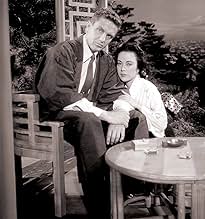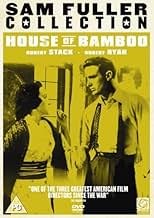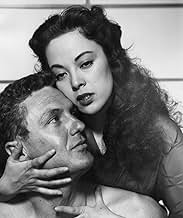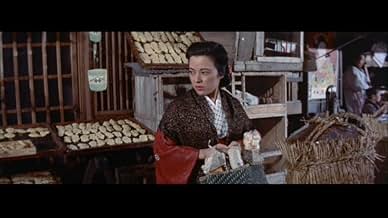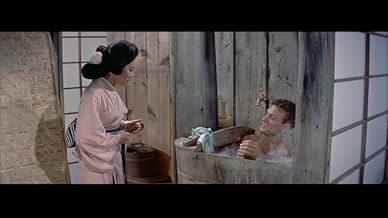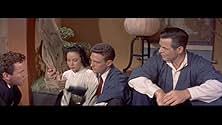NOTE IMDb
6,8/10
4,3 k
MA NOTE
Infiltré dans un syndicat du crime à Tokyo, un enquêteur de l'armée américaine tente d'éclaircir en parallèle la mort d'un collègue de l'armée.Infiltré dans un syndicat du crime à Tokyo, un enquêteur de l'armée américaine tente d'éclaircir en parallèle la mort d'un collègue de l'armée.Infiltré dans un syndicat du crime à Tokyo, un enquêteur de l'armée américaine tente d'éclaircir en parallèle la mort d'un collègue de l'armée.
Clifford Arashiro
- Policeman
- (non crédité)
Sandy Azeka
- Charlie's Girl at Party
- (non crédité)
Harry Carey Jr.
- John
- (non crédité)
Barry Coe
- Captain Hanson's Aide
- (non crédité)
John Doucette
- Skipper
- (non crédité)
Fuji
- Pachinko Manager
- (non crédité)
Samuel Fuller
- Japanese policeman
- (non crédité)
Peter Gray
- Willy
- (non crédité)
Histoire
Le saviez-vous
- AnecdotesAccording to Robert Stack, Samuel Fuller told an actor to go down really low when he passed a 50-gallon drum. Without informing the actor, the director had a sharpshooter on a parallel who shot over the man's head and into the drum. After it blew up, the actor said, "Jesus Christ! Those were real bullets!" Fuller laconically replied, "Don't worry. He knew what he was doing."
- GaffesSandy fires an awful lot of shots from his pistol (which is a revolver) without ever appearing to reload it.
- Citations
Sandy Dawson: Who are you working for?
Eddie Kenner: [posing as Eddie Spanier] Spanier.
Sandy Dawson: Who's Spanier?
Eddie Kenner: Me.
Sandy Dawson: Who else you working for?
Eddie Kenner: Eddie.
- ConnexionsEdited into Shock Corridor (1963)
Commentaire à la une
House of Bamboo may look like a standard B crime-picture, but in amongst the noirish trappings, the somewhat forlornly straight-forward plot, the workmanlike performances, there lurks one of the few genuine portraits of post-War Japanese life ever attempted by an American filmmaker. The director, Sam Fuller, is clearly in love with Japan; his fascination with Japanese culture, art, daily ritual, suffuses House of Bamboo so completely that one almost forgets, at times, what it's supposed to be about. Its story - an undercover army cop infiltrates a group of ex-soldiers running a robbery ring in a rebuilding Tokyo - seems little more than a pretext, an excuse for Sam Fuller to indulge his Japanophilia, his fetish. But Fuller, always the pro, at least pays some attention to his story between excursions onto the Japanese street in search of background detail, local color, bits of peripheral business, and manages despite his preoccupations to deliver a satisfyingly vigorous, if slightly routine-seeming, exercise in crime melodrama.
Fuller, schooled as a journalist, had mastered the art of hard-hitting, well-paced, detail-oriented storytelling, and House of Bamboo is one of his stronger, more tightly-structured works. It's set in Japan in the years just after the war, a time when there is still a strong American military, and criminal, presence in Tokyo. Eddie Spannier (Robert Stack) has just arrived in Tokyo from the U.S., intending to hook up with his old army buddy Webber (Biff Elliot); he learns to his dismay, however, that Webber has been killed by hoodlums, leaving him twisting in the wind. Some casual thuggery at a pachinko parlor brings Spannier to the attention of Tokyo's resident American crime-boss, Sandy Dawson (Robert Ryan); after screening Spannier, Dawson decides to invite the ballsy newcomer into the gang. Spannier, we soon discover, is actually an undercover army cop (he never knew Webber, isn't named Spannier) trying to track down the perpetrators of a recent train robbery which left a soldier dead. As part of his cover, Spannier recruits the dead man Webber's ex-girlfriend, Mariko (Shirley Yamaguchi, merely adequate), a Japanese woman, who poses as his "kimono girl."
Fuller's staging is remarkable from the first moments of the story; the train-heist is carried off with terrific economy and skill, a memorable three-tiered image of the train poised atop an overpass with Mt. Fuji looming in the background (the "real" Japan hovering over the new, American-infested one), punctuated by two grimly matter-of-fact images of the dead soldier's shoes sticking up from the snow. In Tokyo Fuller goes into Pickup on South Street mode, cluttered waterfronts, a sense of teeming life all around the action, if not the sweaty intimacy and sense of menace he brought to his Widmark-starred masterpiece. No one had a better sense of a location than Fuller, who jammed more side detail, more realistic human activity into a few frames of his under-estimated Western classic Forty Guns than exists in all of Fred Zinnemann's hopelessly limp, over-praised High Noon. A perusal of House of Bamboo uncovers such nuggets as the scene where Spannier, played by the disheveled, mainly inexpressive Robert Stack (he wears his trenchcoat like a bathrobe), happens upon a Noh theater rehearsal going on atop a roof, and a later moment where a quaint Japanese fan-dance suddenly morphs into a raucous jitterbug, the dancers ripping off their traditional attire to reveal the '50s get-ups underneath. These scenes are, of course, more than just bits of color; Fuller penetrates the surface of his melodrama by suggesting all sorts of simmering tensions, the sense of American culture bleeding into Japan, changing it maybe not for the better. This material makes up the real, underlying film, the incongruity of traditional Japanese costumes, architectural forms, performance styles finding their way into what would seem to be a standard Hollywood cops-and-robbers exercise, and the larger cultural struggle this would seem to embody. Only the scene where Gary Cooper and Burt Lancaster happen upon the court of the Emperor of Mexico in Aldrich's Vera Cruz tops for aesthetic disjointedness the scene of an apparently half-wasted Stack in his comically shabby hood-just-off-the-boat get-up stumbling upon the garishly dressed and made-up Noh performers, and nearly being knocked off his feet by one of them.
It's amazing the way Fuller uses the camera, not just the fact that he conceives brilliant shots, but that he always knows how and when to use them. He has an almost Griffith-like instinct for the big moment, the expressive image: for instance; the scene where Webber lies dying on a gurney, Fuller shooting the entire thing from a wide, high angle, then slowly coming in when the interrogating officer shows him a picture of his girlfriend, at which point Fuller cuts to a devastating P.O.V., the photograph coming poignantly into focus. Another shot shows his playfulness: a Japanese guy sits at a desk, the camera pulls back, we see that the desk is actually poised atop a balcony over a frantic room where Robert Stack is being prodded by the Tokyo cops. The best moment is less acrobatic but far funnier: Spannier is trying to shake down a pachinko boss, he gets attacked from behind and thrown through a paper wall into an office where his mark, the crime-boss Sandy (played by Robert Ryan with a psychotic pleasantness, that strangely tender note in his voice contrasting his completely deranged behavior), sits balanced on a chair, waiting to greet him. There's always this touch of eccentricity in Fuller, this out-of-leftfield quality, which is what distinguishes his work from that of more predictable, generally better-publicized, unforgivably more-highly-regarded directors (Zinnemann, Kazan, Robson, et al).
Fuller, schooled as a journalist, had mastered the art of hard-hitting, well-paced, detail-oriented storytelling, and House of Bamboo is one of his stronger, more tightly-structured works. It's set in Japan in the years just after the war, a time when there is still a strong American military, and criminal, presence in Tokyo. Eddie Spannier (Robert Stack) has just arrived in Tokyo from the U.S., intending to hook up with his old army buddy Webber (Biff Elliot); he learns to his dismay, however, that Webber has been killed by hoodlums, leaving him twisting in the wind. Some casual thuggery at a pachinko parlor brings Spannier to the attention of Tokyo's resident American crime-boss, Sandy Dawson (Robert Ryan); after screening Spannier, Dawson decides to invite the ballsy newcomer into the gang. Spannier, we soon discover, is actually an undercover army cop (he never knew Webber, isn't named Spannier) trying to track down the perpetrators of a recent train robbery which left a soldier dead. As part of his cover, Spannier recruits the dead man Webber's ex-girlfriend, Mariko (Shirley Yamaguchi, merely adequate), a Japanese woman, who poses as his "kimono girl."
Fuller's staging is remarkable from the first moments of the story; the train-heist is carried off with terrific economy and skill, a memorable three-tiered image of the train poised atop an overpass with Mt. Fuji looming in the background (the "real" Japan hovering over the new, American-infested one), punctuated by two grimly matter-of-fact images of the dead soldier's shoes sticking up from the snow. In Tokyo Fuller goes into Pickup on South Street mode, cluttered waterfronts, a sense of teeming life all around the action, if not the sweaty intimacy and sense of menace he brought to his Widmark-starred masterpiece. No one had a better sense of a location than Fuller, who jammed more side detail, more realistic human activity into a few frames of his under-estimated Western classic Forty Guns than exists in all of Fred Zinnemann's hopelessly limp, over-praised High Noon. A perusal of House of Bamboo uncovers such nuggets as the scene where Spannier, played by the disheveled, mainly inexpressive Robert Stack (he wears his trenchcoat like a bathrobe), happens upon a Noh theater rehearsal going on atop a roof, and a later moment where a quaint Japanese fan-dance suddenly morphs into a raucous jitterbug, the dancers ripping off their traditional attire to reveal the '50s get-ups underneath. These scenes are, of course, more than just bits of color; Fuller penetrates the surface of his melodrama by suggesting all sorts of simmering tensions, the sense of American culture bleeding into Japan, changing it maybe not for the better. This material makes up the real, underlying film, the incongruity of traditional Japanese costumes, architectural forms, performance styles finding their way into what would seem to be a standard Hollywood cops-and-robbers exercise, and the larger cultural struggle this would seem to embody. Only the scene where Gary Cooper and Burt Lancaster happen upon the court of the Emperor of Mexico in Aldrich's Vera Cruz tops for aesthetic disjointedness the scene of an apparently half-wasted Stack in his comically shabby hood-just-off-the-boat get-up stumbling upon the garishly dressed and made-up Noh performers, and nearly being knocked off his feet by one of them.
It's amazing the way Fuller uses the camera, not just the fact that he conceives brilliant shots, but that he always knows how and when to use them. He has an almost Griffith-like instinct for the big moment, the expressive image: for instance; the scene where Webber lies dying on a gurney, Fuller shooting the entire thing from a wide, high angle, then slowly coming in when the interrogating officer shows him a picture of his girlfriend, at which point Fuller cuts to a devastating P.O.V., the photograph coming poignantly into focus. Another shot shows his playfulness: a Japanese guy sits at a desk, the camera pulls back, we see that the desk is actually poised atop a balcony over a frantic room where Robert Stack is being prodded by the Tokyo cops. The best moment is less acrobatic but far funnier: Spannier is trying to shake down a pachinko boss, he gets attacked from behind and thrown through a paper wall into an office where his mark, the crime-boss Sandy (played by Robert Ryan with a psychotic pleasantness, that strangely tender note in his voice contrasting his completely deranged behavior), sits balanced on a chair, waiting to greet him. There's always this touch of eccentricity in Fuller, this out-of-leftfield quality, which is what distinguishes his work from that of more predictable, generally better-publicized, unforgivably more-highly-regarded directors (Zinnemann, Kazan, Robson, et al).
- aliasanythingyouwant
- 3 mars 2006
- Permalien
Meilleurs choix
Connectez-vous pour évaluer et suivre la liste de favoris afin de recevoir des recommandations personnalisées
- How long is House of Bamboo?Alimenté par Alexa
Détails
- Date de sortie
- Pays d’origine
- Langues
- Aussi connu sous le nom de
- Maison de bambou
- Lieux de tournage
- Tokyo, Japon(rooftop playground of the Matsuma department store)
- Société de production
- Voir plus de crédits d'entreprise sur IMDbPro
Box-office
- Budget
- 1 380 000 $US (estimé)
- Durée1 heure 42 minutes
- Rapport de forme
- 2.55 : 1
Contribuer à cette page
Suggérer une modification ou ajouter du contenu manquant

Lacune principale
By what name was La maison de bambou (1955) officially released in India in English?
Répondre



